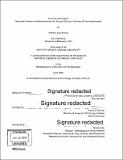| dc.contributor.advisor | Francis O'Sullivan. | en_US |
| dc.contributor.author | Brocks, Annette Josie. | en_US |
| dc.contributor.other | Massachusetts Institute of Technology. Institute for Data, Systems, and Society. | en_US |
| dc.contributor.other | Technology and Policy Program. | en_US |
| dc.coverage.spatial | n-us--- | en_US |
| dc.date.accessioned | 2019-09-16T21:17:49Z | |
| dc.date.available | 2019-09-16T21:17:49Z | |
| dc.date.copyright | 2019 | en_US |
| dc.date.issued | 2019 | en_US |
| dc.identifier.uri | https://hdl.handle.net/1721.1/122159 | |
| dc.description | Thesis: S.M. in Technology and Policy, Massachusetts Institute of Technology, School of Engineering, Institute for Data, Systems, and Society, 2019 | en_US |
| dc.description | Cataloged from PDF version of thesis. | en_US |
| dc.description | Includes bibliographical references (pages 168-184). | en_US |
| dc.description.abstract | We simulate the revenue generated by transmission-connected, small scale energy storage in the energy and capacity markets using historic prices across 10,000 U.S. locations from 2014 to 2017. On average, including capacity market revenue doubles total revenue, such that five-times more systems breakeven. Furthermore, participating in the capacity market shifts the whereabouts of top-earning systems eastwards, and allows top-earning nodes to remain top-earning for longer. That being said, revenue generation still varies greatly across years for a given location. In order to reflect the contribution of storage to grid reliability during times of stress, we treat capacity market revenue as a function of output during given hours throughout the year; changing the identification of these hours - whether taken as some percent of top demand hours, or as determined by market regulators- can increase revenue up to ten-times that of energy market participation alone. Durations shorter than 8-hours are found to more significantly contribute to reliability than predicted via simplistic analysis of the durations of high risk hours. Considering that participation in the capacity market, as modeled, will always increase total revenue, and that storage units will change dispatch behavior even to earn comparatively small increases in total revenue, designing markets that appropriately incentivize system reliability is a critical task of regulators. | en_US |
| dc.description.statementofresponsibility | by Annette Josie Brocks. | en_US |
| dc.format.extent | 186 pages | en_US |
| dc.language.iso | eng | en_US |
| dc.publisher | Massachusetts Institute of Technology | en_US |
| dc.rights | MIT theses are protected by copyright. They may be viewed, downloaded, or printed from this source but further reproduction or distribution in any format is prohibited without written permission. | en_US |
| dc.rights.uri | http://dspace.mit.edu/handle/1721.1/7582 | en_US |
| dc.subject | Institute for Data, Systems, and Society. | en_US |
| dc.subject | Technology and Policy Program. | en_US |
| dc.title | The Past as prologue : the value creation of batteries on the U.S. electric grid as a function of time and location | en_US |
| dc.title.alternative | Value creation of batteries on the U.S. electric grid as a function of time and location | en_US |
| dc.type | Thesis | en_US |
| dc.description.degree | S.M. in Technology and Policy | en_US |
| dc.contributor.department | Massachusetts Institute of Technology. Institute for Data, Systems, and Society | en_US |
| dc.contributor.department | Massachusetts Institute of Technology. Engineering Systems Division | |
| dc.contributor.department | Technology and Policy Program | en_US |
| dc.identifier.oclc | 1117774404 | en_US |
| dc.description.collection | S.M.inTechnologyandPolicy Massachusetts Institute of Technology, School of Engineering, Institute for Data, Systems, and Society | en_US |
| dspace.imported | 2019-09-16T21:17:47Z | en_US |
| mit.thesis.degree | Master | en_US |
| mit.thesis.department | ESD | en_US |
| mit.thesis.department | IDSS | en_US |
